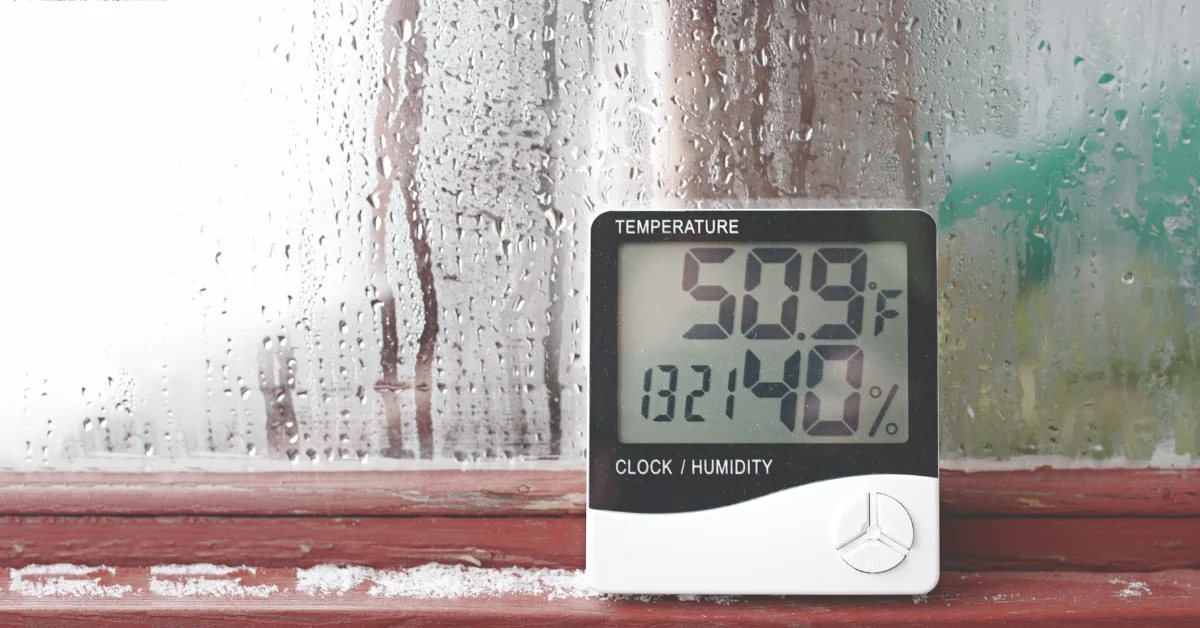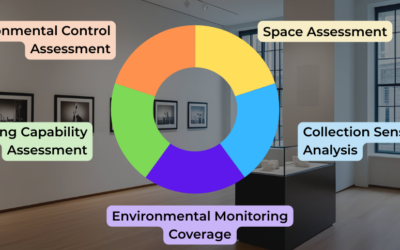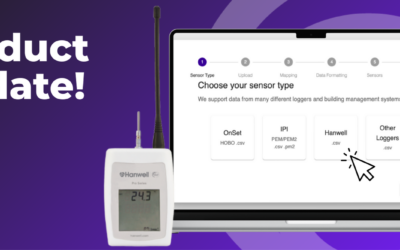Humidity, or more accurately for conservation purposes, relative humidity (RH), is one of the most important environmental factors that affect the preservation of collections. Too high or too low RH can cause damage such as corrosion, cracking, warping, and even fading. Higher levels of RH are more conducive to pest proliferation and can increase the risk of mold growth, which may then lead to structural damage, surface staining, chemical changes, loss of original appearance, a potential spread to adjacent objects, and health and safety concerns. To monitor and control the relative humidity levels in collections storage and display areas, collections care professionals need reliable and accurate humidity data loggers.
A humidity data logger is a device that measures and records the relative humidity and, generally, also the temperature of the surrounding air. It can be placed inside a display case, a storage cabinet, a room, or a building. The data logger can store the data in its internal memory and/or transmit it wirelessly to a computer or a cloud service. The data can then be analyzed and used to establish a preservation environment for the collections by adjusting humidity and temperature conditions, planning preventive conservation measures, and identifying issues with both passive and active environmental controls.
But how do you choose the best humidity data logger for your collections? What are the features and specifications that you should look for? What are the advantages and disadvantages of different types of humidity data loggers? What is everyone else using? In this article, we will answer these questions and help you find the best humidity data logger for your needs in 2023.
Know what you are looking for in a humidity data logger
First of all, when you are looking for a humidity data logger, make sure you are looking for a device that will give you relative humidity readings, not just absolute humidity. Absolute humidity is measured in grams per cubic meter (g/m3). This can be important when you are looking for leaks or other ways in which moisture is entering or leaving your spaces. However, for determining safe conditions for your objects, you are interested in the measure of moisture in the air relative to the current temperature, which is expressed as a percentage. Be aware that temperature is a critical factor in determining RH, so that a good RH data logger will ideally be measuring temperature too and then giving you the calculated number you need.
How do humidity data loggers work?
The sensor inside your data logger will be measuring moisture based on electrical conductivity. Generally speaking, there will be a moisture-absorbing material in between two conductive materials (some sort of metal). As the material in the middle absorbs or releases moisture to achieve equilibrium with its environment, it will be either more or less likely to conduct electricity (because of the ions moving about freely in the water).
Depending on your brand and type of sensor, your device will be using either resistance (opposition to the electric current) or capacitance (ability to store electricity). These measurements will then take into account the temperature reading also taken by your device and then calculate a relative humidity reading for you.
Types of humidity data loggers
There are many types of humidity data loggers available on the market, but for our purposes, we can divide them into two categories: manual download loggers and wireless.
Manual download or USB humidity data loggers are usually (though not always!) cheaper than wireless ones. Their cost will be tied to the quality of the sensor they have inside. They are just as easy to install as wireless ones as they normally only need placing in the desired spot. However, they have some drawbacks, such as:
- They require staff to take time to go around downloading their logged information.
- They can accidentally overwrite information if staff sets measurements to be taken too frequently and then miss the deadline to download the data before the equipment runs out of space.
- They are not monitoring in real-time as the data cannot be seen until it is downloaded.
- They are generally sold as a one-time exchange and will have limited customer service if anything goes wrong. If they stop working after a customary 1-year warranty, the user will simply have to get a new one.
- They might not be adjustable when they drift, so they are completely disposable at the end of their useful lifetimes.
- They have limited battery lives. In our experience, a 3.6V lithium battery in a USB logger will last about one year if it is taking measurements every 30 minutes. That means you will be purchasing (and discarding) enormous amounts of batteries over time.
Wireless humidity data loggers are also battery-powered and use radio frequency (such as WiFi or Lorawan) or Bluetooth technology to transmit the data wirelessly to a receiver, a computer, or a cloud service. They are usually more expensive than manual download ones although, again, you are also paying for the quality of the sensor inside. Some of the advantages of wireless humidity data loggers are:
- They can be placed in hard-to-reach or inaccessible areas, such as inside walls or ceilings because you will not have to get to them to download the information. Of course, keep in mind that if you are putting loggers inside walls, you should make sure this does not interfere with your network signal.
- Depending on the type of network they use, they can cover a larger area and collect data from multiple locations.
- Depending on the brand you buy, they will upload the data automatically to the internet, so that you can access it remotely – even outside of your institution and on mobile devices.
- Because they are logging data in real time, they will be able to send you alerts if the humidity suddenly spikes or drops. This will allow you to react before the situation gets worse.
Important note: You should be aware that Bluetooth technology will be mostly used to help you download the data without a physical connection to the logger (USB or cabled). This means that Bluetooth loggers do not necessarily perform automated data upload to a cloud or service and may still require a person to go around downloading the information with a BT-enabled device. This issue will only be solved if you also get a gateway to collect the data for you.
Features and specifications of humidity data loggers
When choosing a humidity data logger, you should consider the following features and specifications:
- Accuracy: This is the degree of closeness between the measured value and the true value of humidity. The accuracy of a humidity data logger depends on several factors, such as the quality of the sensor, the calibration method, the environmental conditions, and the frequency of use. Generally speaking, you should look for a humidity data logger with an accuracy of ±3% or better for collections care purposes.
- Conserv’s SCS-3 sensor uses the Sensirion SHT45 which is accurate to ±0.1°C / ±1.0% RH.
- The HOBO MX1101 has ±0.2°C and ±2% to ±6% RH depending on the temperature.
- The now discontinued PEM2 used a Sensirion SHT75 ±0.3°C and ±2 to ±3.5%RH depending on the temperature.
- Drift: Annual drift is the amount of accuracy that a sensor loses each year. It is normal and expected for a sensor to degrade over time, which will affect its accuracy. The higher your drift, the more often you will need to calibrate or even just replace your device.
- Conserv’s Sensirion SHT45 sensor has a drift of <0.2%RH per year.
- The PEM2 SHT75 sensor has a drift of <0.5%RH per year.
- The HOBO MX1101 has a drift of <1%RH per year.
- Resolution: This is the smallest change in humidity that the data logger can detect and record. Resolution is usually expressed in decimal points or digits. For example, a resolution of 0.1% means that the data logger can record changes in humidity as small as 0.1%. The resolution of a humidity data logger depends on the sensitivity of the sensor and the sampling rate. For the purposes of everyday collections care, all of the following sensors are more than adequate in their resolution.
- Conserv’s SCS-3 Sensor has a resolution of 0.01%RH.
- The HOBO MX1101 also has a resolution of 0.01%RH.
- The datasheet for the Sensirion SHT75 sensor in the PEM2s states a humidity resolution of 0.05-0.4% RH with 0.05% being the most likely most of the time.
- Range: This is the minimum and maximum values of humidity that the data logger can measure and record. Range is usually expressed in percentage points or units. For example, a range of 0-100% means that the data logger can measure and record humidity from 0% to 100%. The range of a humidity data logger depends on the type and capacity of the sensor. Although you will probably start to worry anyway if your collections spaces fall under 35% or go over 65%, we recommend you just get the full range of 0-100% so you can get a real picture of what’s going on since you will likely start to get actual condensation in your spaces at 100%RH.
- All versions of Conserv sensors and the PEM2 have a 0-100% range while the HOBO MX1101 only goes 0-95%RH.
- Memory: This is the amount of data that the data logger can store in its internal memory before it needs to be downloaded or transmitted. Memory is usually expressed in kilobytes (KB), megabytes (MB), gigabytes (GB), or number of readings. For example, a memory of 16 MB means that the data logger can store up to 16 MB of data before it needs to be downloaded or transmitted. You need not be as concerned with memory with automatic upload wireless humidity data loggers as they will be transmitting the information to a cloud or server continuously. If you decide to get USB data loggers for humidity, you would need to make sure you have enough memory to match your frequency of readings and your frequency of data download. Remember that more readings means less time in between downloads and also higher battery use.
- The HOBO MX1101, for example, has 128kb memory, which they convert to a maximum of 84,650 measurements. If you were to take measurements every 30 mins, this would convert to 42,325 hours, which is 4.8 years.
- The EL-USB-2 humidity data logger only has space for up to 32,764 readings (counting temperature and humidity separately, so really you can think of it as half that number). If you were to take measurements every 30 mins, this would mean 4 readings per hour, which means you have 8,191 hours or 341 days before you run out of memory.
- Power source: Power is an important consideration because, unless you are plugged into an electrical outlet, it reflects how often you will have to change batteries, and importantly, what kind of batteries you will need to get.
- The HOBO MX1101, for example, uses regular AAA 1.5V batteries.
- PEM2s use regular 1.5V AA alkaline batteries, which their specifications state should last ±5 years.
- The Lascar USB models, however, use the ½ AA or 3.6V battery, which cannot be purchased at any in-person store. It looks like a short, stocky battery.
- Conserv uses AA 3.6V batteries which look like the regular AA ones you can buy in the store except that the store ones are 1.5V and these ones are 3.6V. Given that Conserv uses LoRaWAN network technology, the data logger will use much less energy uploading data, so you can be sure that the batteries will last very close to 3 years, which means Conserv will replace your data logger before you run out of batteries.
Hidden features and costs of a humidity data logger
The points above relate directly to the quality of the sensors and hardware in your device. However, don’t forget that when you choose a data logger, you are also committing to a specific system and way of working. The cost that you see displayed on the price tag of your sensor does not necessarily reflect the real cost of operating the equipment over time. Make sure you are fully aware of this and don’t forget to think about the following points:
- Wireless vs. manual download loggers will affect your staff time, so figure out which one is more expensive for your particular situation over time.
- Battery life will also affect staff time and budgets.
- Accuracy over time will decrease due to annual drift, so the higher the drift on your sensor, the less time you will have before it becomes too inaccurate to be useful to you.
- Customer service or lack thereof can also affect your use of equipment. If anything goes wrong, you may (or may not) be able to get support or replacement.
- If sustainability is a concern to you, think about how many batteries you will have to discard over time. If your sensor and logger are cheap from the start, you may have to discard the whole device more often than you would like. Is this an acceptable trade-off to you?
Conclusions
If you are on the market for a new humidity data logger, make sure you look at the specifications of both the sensors and the device you are seeking to purchase. While your main concern may be around cost, don’t forget about the hidden costs too – the ones that come after you buy. Consider staff time, network capabilities, location where you intend to place the loggers, accuracy, resolution, range, memory, and power source. If you would like to try the Conserv system with its high quality, high accuracy sensors, customer support, long battery life, and sustainable reuse of hardware parts at the end of your logger’s life, reach out to us and we’ll be happy to talk!
If you have any questions about environmental monitoring, integrated pest management, or just want to talk about preventative conservation, please reach out to us! Don’t forget to check out our blog or join our community of collections care professionals where you can discuss hot topics, connect with your peers or even take a course to get familiar with the Conserv platform.





